THE HICKEYS OF LOUGH GUR
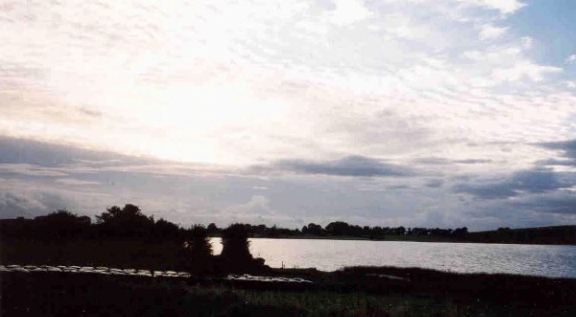
Sunset at Lough Gur
Thomas and Ellen Hickey and
their family lived in a small stone house with a thatched roof
by Lough Gur, the Enchanted Lake,
in County Limerick. The house had 2-4 rooms with two windows
in the front. They also had a stable. The family leased Lot
11a, which was about 6 acres from the Count de Salis. Thomas
was a small farmer with this quantity of land.
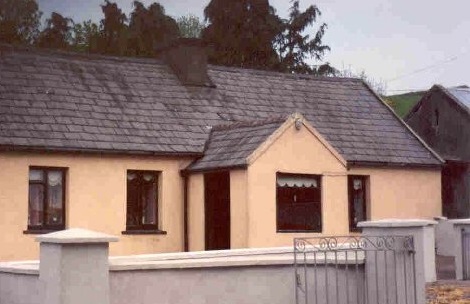
The Hickey's home in Lough Gur
Knockainy was a large parish. The following Hickey
families were found in Knockainy parish during the early
1800s:
Ballinvrana: This Hickeys in Ballinvrana were
associated with the Carroll family, who were often witnesses
or sponsors.
Patrick Hickey, farmer of Ballinvrana
married Sally Carroll 1 February 1815 in Knockainy, and had
these children, all baptised in Knockainy parish:
Margaret, christened 29 June 1816
Mary, christened 26 August 1818
Catherine, christened 29 March 1820
Bridget, christened 26 January 1822
John, christened December 1823
Michael, christened 5 March 1826
Patrick, christened 4 April 1828
Edmond, christened 24 March 1830
James, christened 4 February 1832 (possible twin)
Edmond, christened 4 February 1832 (possible twin)
Edmond, christened 24 June 1833 (sponsor: Margaret Hickey)
James, christened 7 June 1835 (sponsor: Mary Hickey)
Daniel, christened 19 February 1837
Catherine, christened 27 August 1838 (sponsor: Ellen
Hickey)
Michael Hickey was a witness at the marriages of James
Kelly and Mary O'Brien in 1810, of Patrick Vaughn and Brigid
Carroll of Ballinvrana in 1810, and of John Riordan of
Dromin and Mary Shehan in 1811
.
Pat Hickey was a witness at the marriage of Mathew
Garritt of Hospital and Mary Hickey of Kilballyowen in 1814.
John Hickey of
Patrickswell and Anne Donovan had these children
baptised in Knockainy parish:
Mary, christened 11 August 1821
Bridget, christened 26 November 1825
John Hickey and Mary Slattery had a child
baptised in Knockainy parish:
Patrick, christened 22 February 1817
Anne, christened January 1824
Maurice Hickey married Ellen Sherwin 27 November 1823 in Dromin and Athlacca parish (a neighboring parish), and had these children baptised in Knockainy parish:
Mary, christened 6 December 1824
Thomas, christened 29 September 1827
William, christened 1 January 1830 (sponsor: Mary Hickey)
Matthew Hickey and Eliza Cherry had a child baptised in
Knockainy parish:
Mary, christened 7 August 1830
Bridget Hickey of Knockroe townland married John
McGrath 27 May 1816 in Knockainy. This is most
certainly Thomas' sister, as she is the right age, and the
McGraths are found living next to the Hickeys in the land
records. The others listed above may be brothers, or even a
father for Thomas.
John Hickey was mentioned in a newspaper article in the Saunder's
Newsletter on February 23, 1836:“John Hickie, from
Loughgur, was waylaid on Tuesday night last, and received a
very severe fracture.”
The Limerick Chronicle newspaper in 1838 mentions the Hickeys
of Lough Gur:
"Limerick Chronicle 10/03/1838, report, John Hickey struck on the head with a stone by William Hawe, found guilty of manslaughter
County Crown Court – Thursday.
Mr. Sergeant Greene took his seat this morning at 9 o’clock, and was engaged until eleven fiating the presentments. The prisoners were then arraigned , for the first time since the opening of the Commission, and the Long Panel called over, from which the following Jury were sworn – Thomas Travers Adams, John Peppard, Hugh Finch, John Barry, Thomas Bennett, James Barry, Henry Bouchier, Paul Erson, James Ievers, Myles J. Mason.
William Hawe was indicted for that he, on the 16th February, in the 6th of his late Majesty, at Loughgur, did assault John Hickey, giving him a stroke of a stone on the right side of the head, of which he died.
Garrett Punch sworn – Knew John Hickey; he is dead; was returning from a funeral the day Hickey was beat; there were several returning along with him; saw a row on the road between the deceased and a party of men who were with the prisoner; saw the deceased struck, but cannot say the prisoner struck him; he was among the party that were beating the deceased.
Cross-examined – Drank no whiskey that day; did not want it; there was a race after the funeral, but did not wait to see it; there is a public-house near the place where the deceased was beat; did not see a man of the name of Connell strike deceased.
Maurice Hickey sworn – The deceased was brother to witness; knows the prisoner Hawe; saw the prisoner and a man named John Connell strike his brother; the prisoner struck him with a stone which knocked him down; the prisoner struck deceased in the head when down; Connell also struck him; his brother was brought to his sister-in-law’s by neighbours that found him on the road; he was afterwards taken to the house of Doctor Fitzgerald, who said his head was fractured, and directed that he should be taken to Hospital, which was done.
This witness’s evidence was given in Irish through the interpreter, and previous to being examined, he was asked by Mr. Freeman if he could speak English, in which language he replied “I could not”.
Dr. Twaites sworn – The deceased was admitted in the County Infirmary, on the 17th February, 1836; he had an extensive fracture on the right side, of the back of his head; the bones were broken and the brains came out; he died of the wound on the 7th March.
Owen Rourke, policeman, sworn – Is stationed in Bruff; when he received orders to arrest the prisoner, he searched for him, but to no effect.
Constable Chas. Hickson proved to having arrested the prisoner at Rahee, on the 26th last December; when conveying him to prison, he said, without being asked about anything – “If I am transported for this, I’ll have revenge for it.” The prisoner was found lying under some straw, naked.
Doctor Gerald FitzGerald sworn – The witness examined in the Irish language was for some time in his employ; often heard him speak some sentences in English.
James Raleight, John Dwyer, and Daniel Dwyer were sworn for the defence, with a view to shew that the prisoner was not present when the deceased was struck. Guilty of manslaughter. To be imprisoned six months at hard labor."
Another article discusses the trial of John Connell for
killing John Hickey:
Limerick Chronicle – July 16, 1836
John Connell for the murder of John Hickey,
at Loughgur, in this county.
Maurice Hickey, an Irish witness – Is brother to
deceased; was standing on the road in Loughgut the day his
brother was assaulted; was near his brother; one Howe first
struck him with a stone and knocked him down, and on
attempting to rise, the prisoner (Connell( struck him with
another stone on the head; when the wound was dressed the
brain, he was told, protruded through the wound; he died 21
days after in Hospital; Howe is on his keeping; his brother
was not drunk.
Cross-examined – Has no call to the fighting parties of
either Loughgur or Grange; when he heard people were
watching his brother, he went out to his assistance; witness
doesn’t know if his brother was wheeling, but wasn’t
wheeling himself; on his oath neither he nor his brother
wheeled; it was at the funeral his brother was; swears he
knows nothing about the races, nor does he know whether it
was the funeral people or those of the races who were
assembled; he was stripped when going for the police after
his brother was killed; cannot swear whether he had stones
or not in his hands, as he didn’t know what he was doing
when his brother was killed; he took off his coat when
Connell’s friends wouldn’t allow him to go for the police;
he was never engaged in a fight, nor in gaol, nor was
information ever lodged against him.
Patrick Punch – Knows prisoner; knew John Hickey;
was at the funeral; knows John Connell, who hit himself on
the mouth with a stone and softened two of his teeth.
Garrett Punch – Knows prisoner; knew deceased (Hickey);
was by when Howe struck him; knows no more, as he retired;
saw the party after hurrooing; saw stones thrown, after Howe
struck deceased; they were wheeling before deceased was
struck.
Michael Hayes – Is no relation to the prisoner;
recollects the affair at Loughgur. Knows prisoner and Maurice
Hickey, saw Maurice Hickey after his brother
was killed, and told him of it. Hickey asked witness in a
frightened manner who killed him; Maurice Hickey had
his coat on then; he then wheeled, and a chap, a cousin of
his, told him the man who struck him is in Jack Bayly’s
house.
Dr. Thwaites, examined – Was sent to Hospital with a
back fracture on the back of the head, the wound was given
on 16th February and he died on the 9th March.
Thomas Casey – Is not relative to the prisoner. Knows Maurice
Hickey, did not see him; deceased was wheeling, and
witness said he’d complain the whole of them to the Priest;
he took deceased by the breast to bring him in, and deceased
desired him to go about his business.
Timothy Daly – Saw deceased struck; by virtue of his
oath the prisoner did not strike deceased, he was struck
with two stones, was standing by looking on; does not know
who struck deceased; saw prisoner then; saw the prisoner
wheeling for Dooly.
Gerald Fitz-Gerald, M.D. – Is not acquainted with
prisoner. Knows his family; prisoner has the character of a
very orderly peaceable quiet man; if he heard of his
wheeling it would not change his opinion of him, as the same
may be said of every one of his class in the county.
John Carney – Saw deceased after being struck; did not
see prisoner strike him, nor did he see him at all.
Daniel Dwyer – Knows prisoner; on his oath prisoner did
not strike deceased; saw who struck him; it was a man
passing with a rock which he had under his coat; did not
know him.
Verdict – Guilt of Manslaughter.
Note: Wheeling was a
ritualized form of taunting and challenge used in faction
fights.
Thomas Hickey appeared in the
Tithe Applotment of 1833 in Knockrough townland. John
McGrath was listed in the next lot.
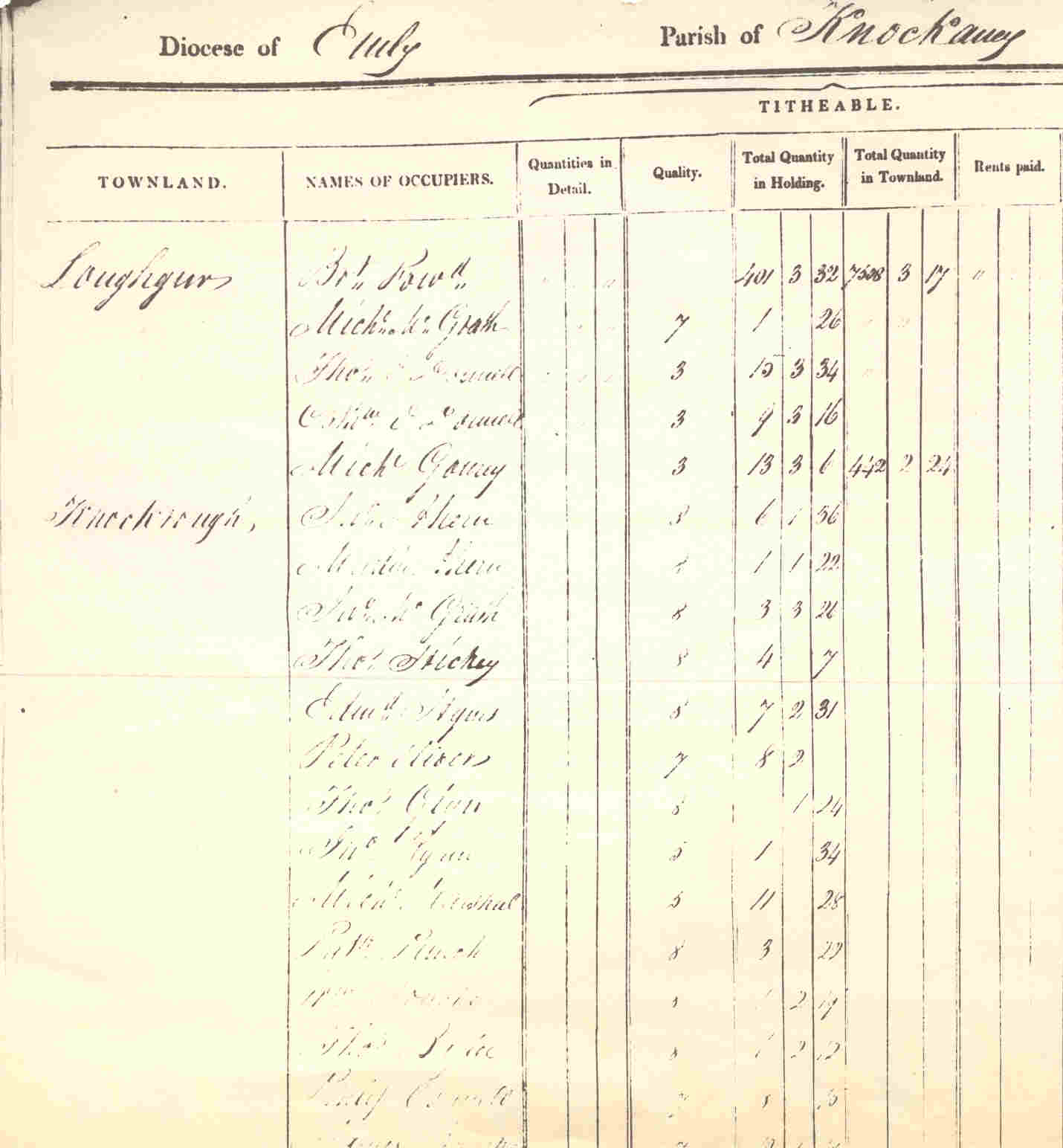
Tithe Applotment, Knockrough, Knockaney parish, 1833
The occupants of Knockrough townland at that time were:
John Ahern
The Hickeys were listed in the Famine Relief Papers in 1844-7 in a list of the tenants of the Loughgur Estate: "These records consist of letters and other documents received by the Commission primary between November 1845 and May 1847. These came from members of local relief committees, lieutenants of counties, clergy, and other citizens, and touch on a broad spectrum of issues." The document is titled Continuation of Loughgur Estate. The Hickeys listed in the same townland are most likely Thomas Hickey, his sons Patrick and Thomas, and his brother Maurice. Thomas and Maurice would be in their forties. Patrick and Thomas would be in their late teens.
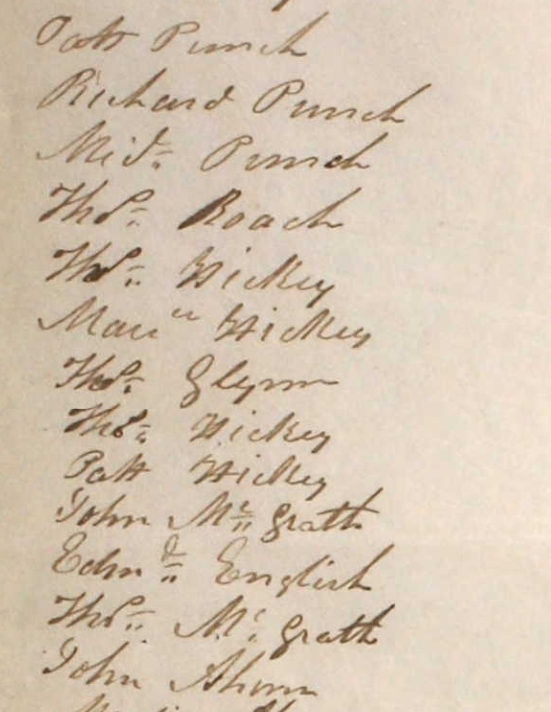
A list of able-bodied men on the Loughgur Estate, including Thos Hickey, Maurice Hickey, Thos Hickey, and Patt Hickey, 1844-7
The end notes to this list says " Total 600 willing and ablebodied men all looking out for enmployment.
Note The lists of which this is a copy, true and correct, has been handed to me and am in my possession to be produced if required
to put down any useless caviling opposition to this most useful and necessary Public Work."
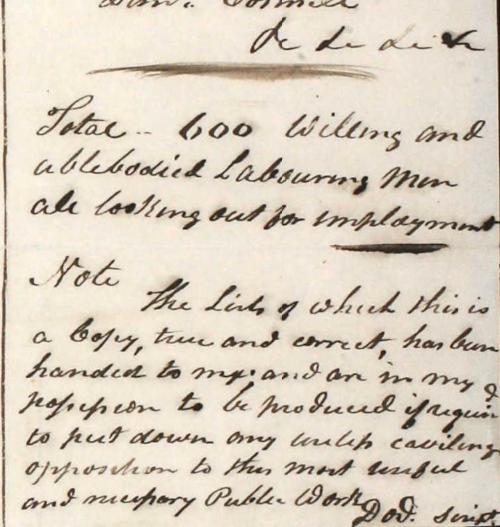
The Hickeys of Lough Gur were mentioned in a newspaper article in the Limerick Leader on 7 March 1845, when Maurice was a witness at a murder trial:
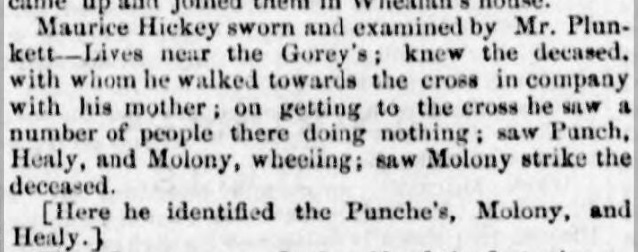
"Maurice Hickey sworn and examined by Mr. Plunkett - Lives near the Gorey's; knew the deceased, with whom he walked towards the cross in company with his mother; on getting to the cross he saw a number of people there doing nothing; saw Punch, Healy, and Molony, wheeling; saw Molony strike the deceased. (Here he identified the Punche's, Molony, and Healy.)" (Limerick Leader, 7 March 1845) Wheeling was a ritualized form of taunting and challenge used in faction fights.
The House Books created in
1848 in preparation for Griffiths Valuation show Thomas
Hickey in Lough Gur, with Bridget McGrath next door.
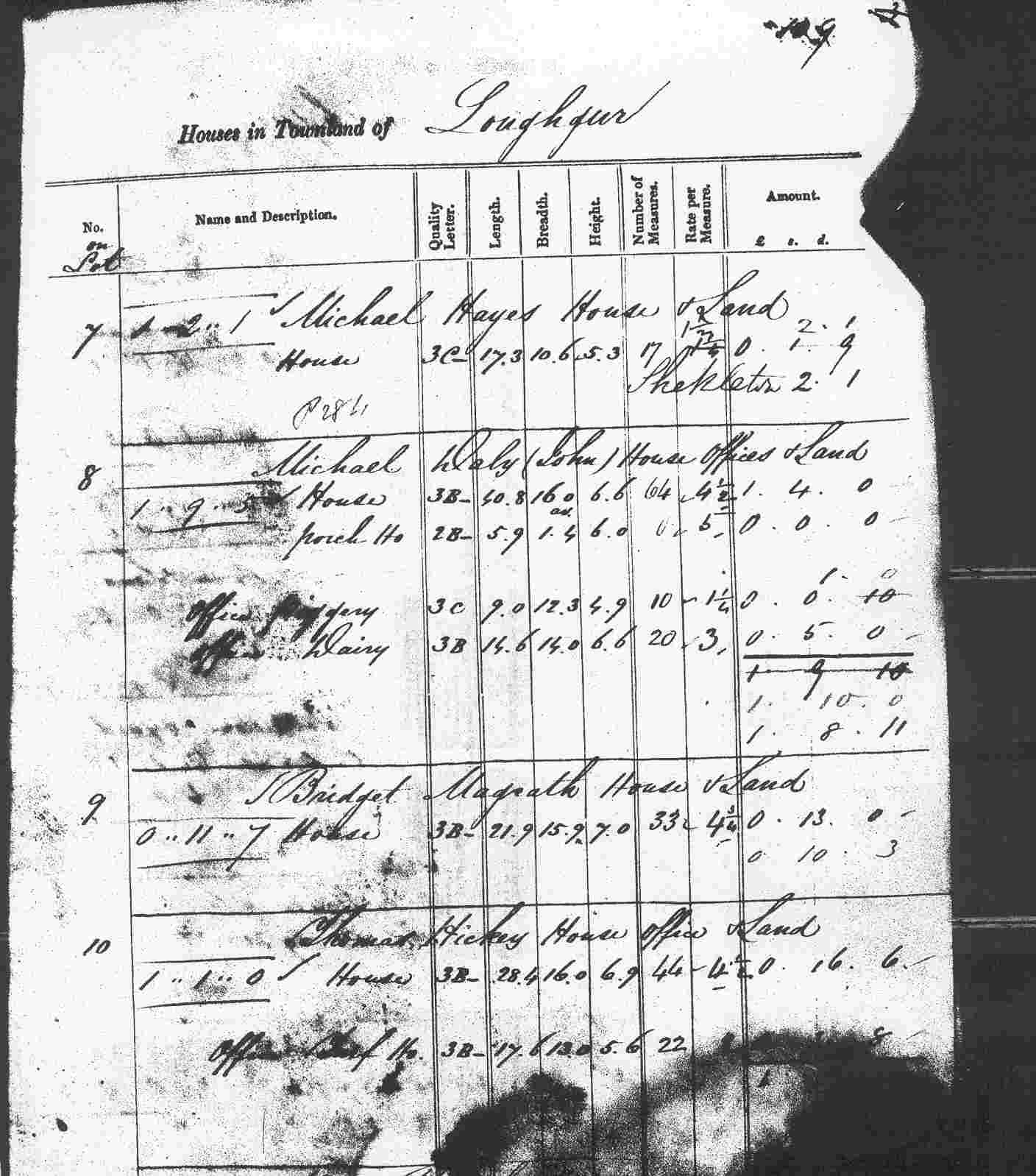
House Book, Loughgur, Knockaney parish
Thomas Hickey had a house that was 28.4 feet long by 16
feet wide, and 6.9 feet high. The house was rated 3B-. That
means it is a thatched house of stone walls with mud mortar,
or mud walls of the best kind. The condition is medium -
deteriorated by age, and not in perfect repair. He also had
a turf house that was 17.6 feet long by 13 feet wide, and
5.6 feet high. The property included a house, outbuildings,
and land.
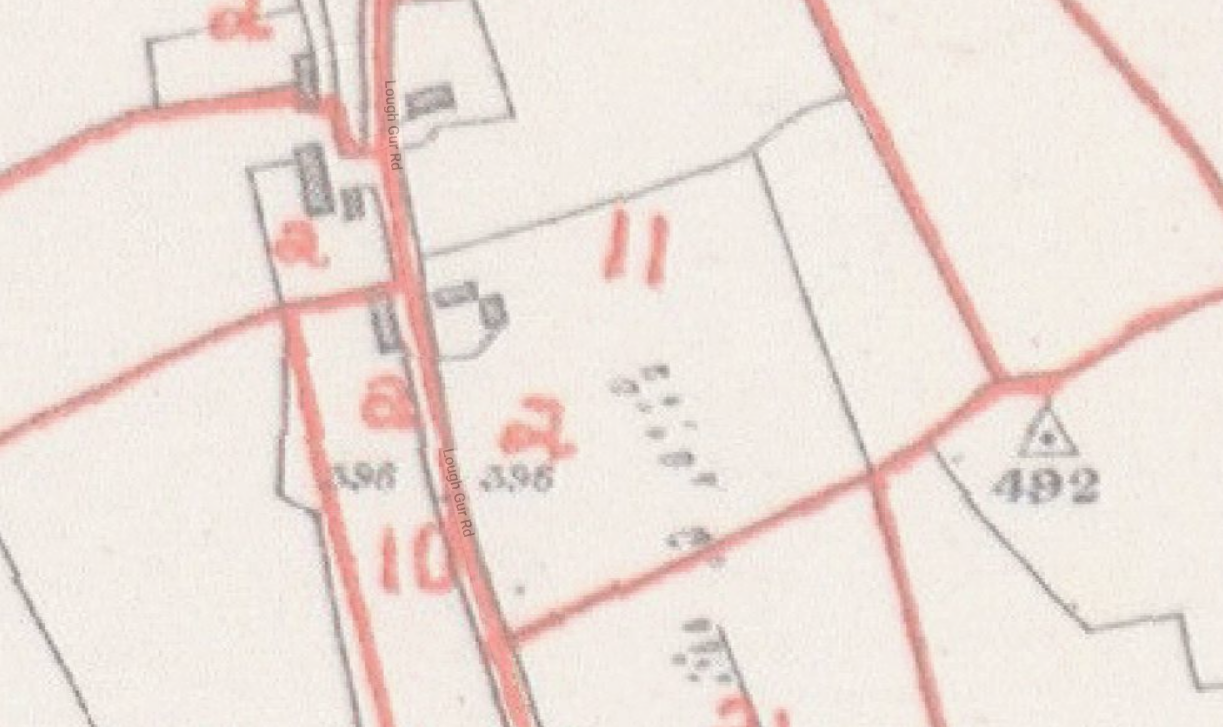
Ordinance
Survey map showing the Hickey property in Lot 11.
This map was created in preparation for
Griffiths Valuation in 1851.
The detail shows the location of houses and
outbuildings.
The Tenure Book created at the same time, on 16 November
1848, showed that Thomas Hickey leased the house and land
from the Count de Salis. The lease was created in 1809, and
was for the longer of 31 years or three lives. Since the
time period of 31 years had passed in 1840, and Thomas
Hickey must have been a small boy of about nine years old
when the lease was created, he must have been listed as one
of the lives by his father or perhaps grandfather. This type
of lease had been very common in Ireland in the 1700s, but
was becoming rare in the 1800s, as landlords sought
short-term leases.
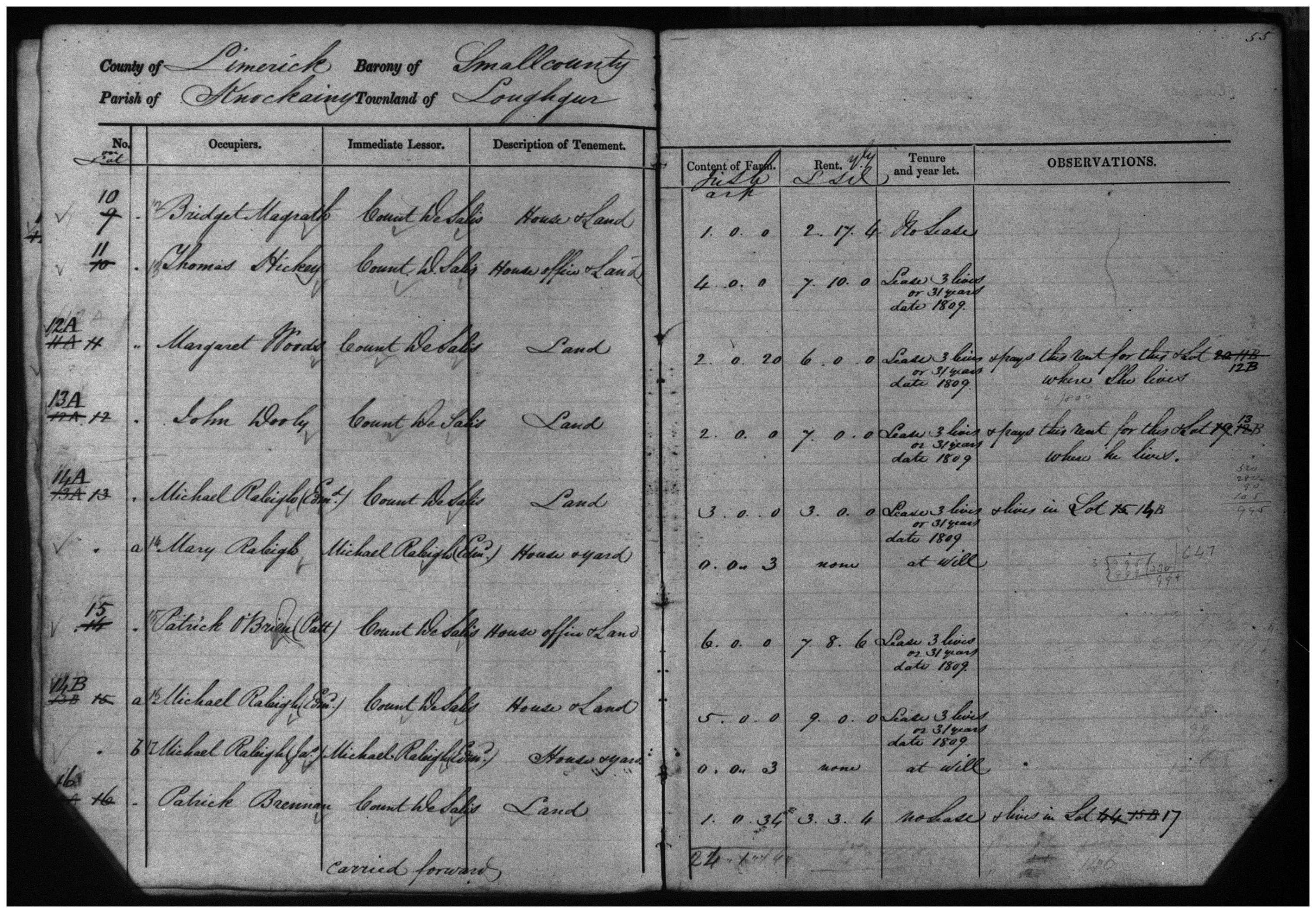
The other piece of property
leased by a Thomas Hickey is also found in the House Books.
It was a house only, with no land. The house was 23.9 feet
long by 12 feet wide, and 5.6 feet high. It was rated 3C-.
That means it was a thatched house of stone walls with mud
mortar, or mud walls of the best kind. The condition was old
and dilapidated, scarcely habitable. The house was leased
from Patrick Gourey, at will. This was a lease for the house
only, with no land. Patrick rented the house, offices and
land from the Count de Salis.
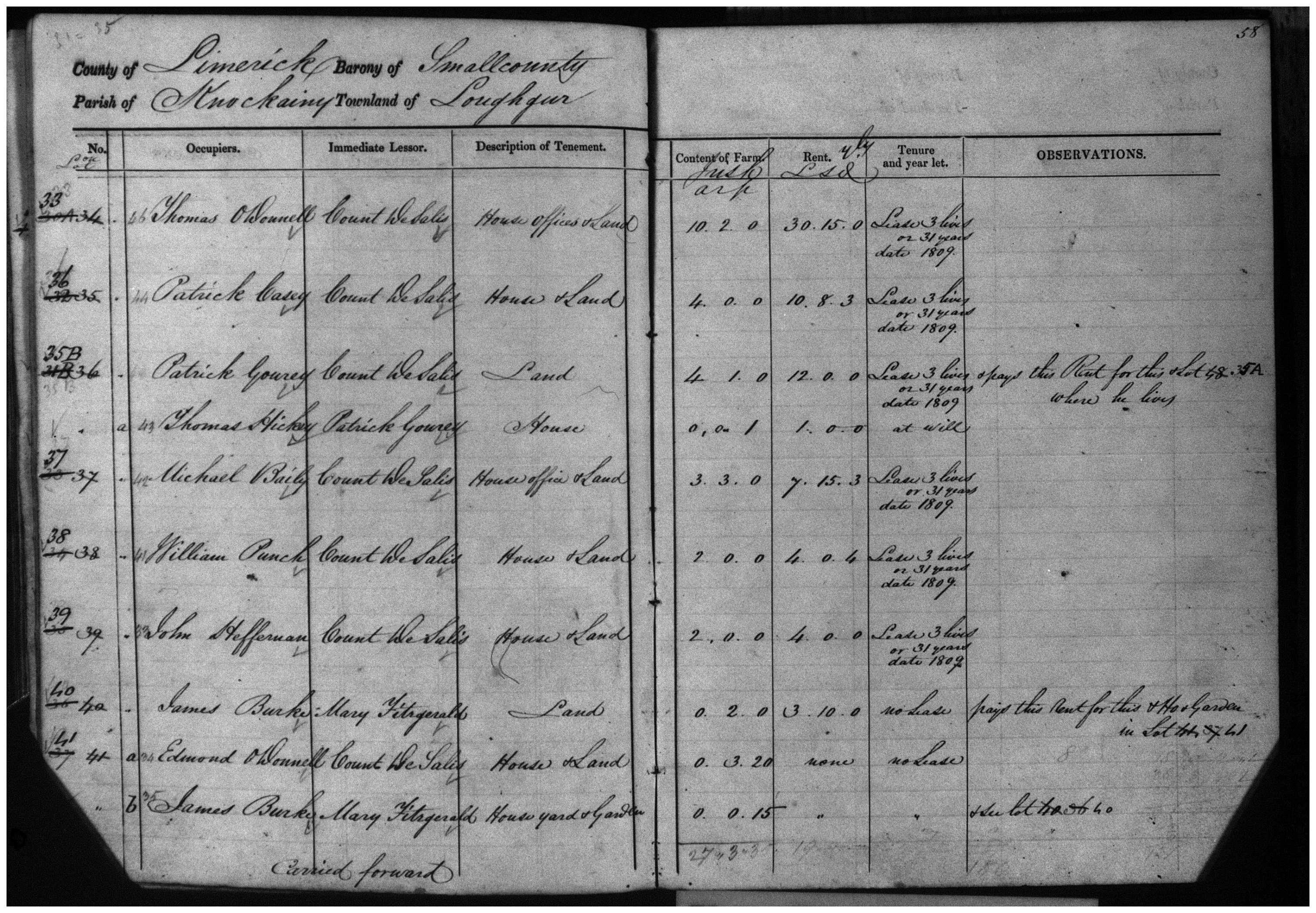
Tenure
book - Thomas Hickey rented the house at
will, not on a long-term lease.
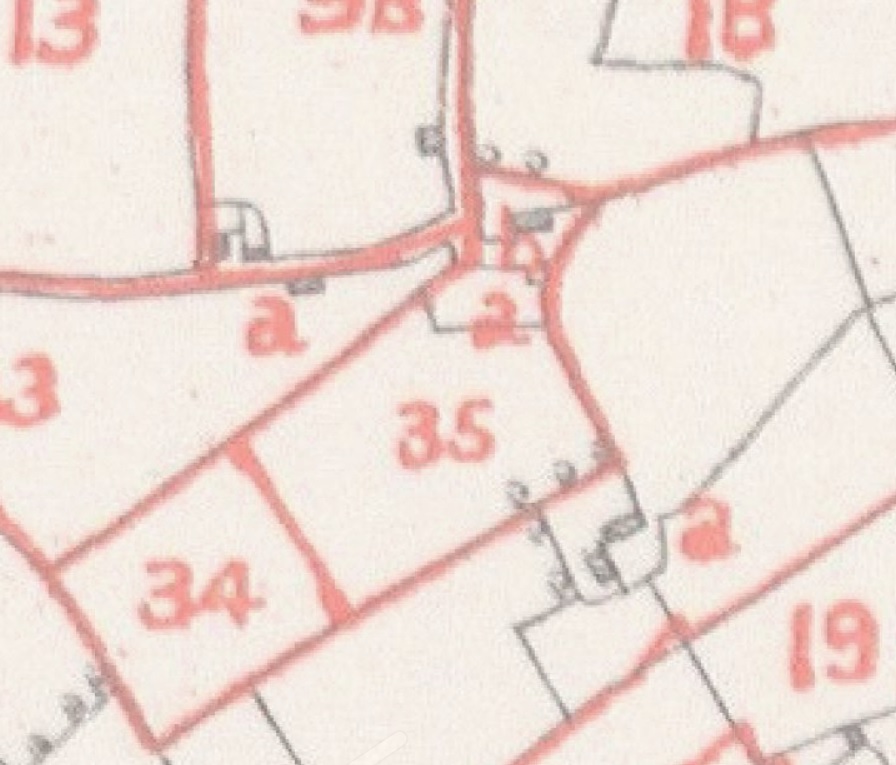
Ordinance Survey map
showing the Hickey property in Lot 35b.
This map
was created in preparation for Griffiths Valuation in
1851.
The detail shows
the location of the house on the lot.
The fact that Thomas Hickey
leased two houses in 1848 leads to the possibility that the
Thomas Hickey listed in the Tithe Applotment in 1833
was really Thomas Hickey's father, with the same name, and
that Thomas Senior and Thomas Junior each occupied a house
in 1848. The smaller house with no land may have been
occupied by the elder Thomas Hickey, and the house and farm
occupied by the younger Thomas Hickey and his family. In
considering the naming patterns for the family, our Thomas'
first son was Patrick, and his second son was Thomas. His
first daughter was named Mary. Bridget, his sister, had a
first son named Thomas and a first daughter named Mary. His
possible brother, Maurice, had a first son named Thomas and
a daughter named Mary. Another potential brother, John, had
his first daughter named Mary. It is worth considering the
possibility that our Thomas' parents may be Thomas and Mary.
The three lives lease created in 1809 would provide
information that may resolve the question if it can be found
in estate records.
The landlord, Count de Salis has been described as a kind
and lenient landlord: "The Lough Gur estate fell into the
hands of the Count de Salis and he proved himself a kind
and just landlord to his tenants. He was well
known for his leniency to his tenants. He built many
houses in his estates and the tenants afterwards became
the possession of those houses when the estate was
divided." (The Landlord: Count del Salis; www.duchas.ie)
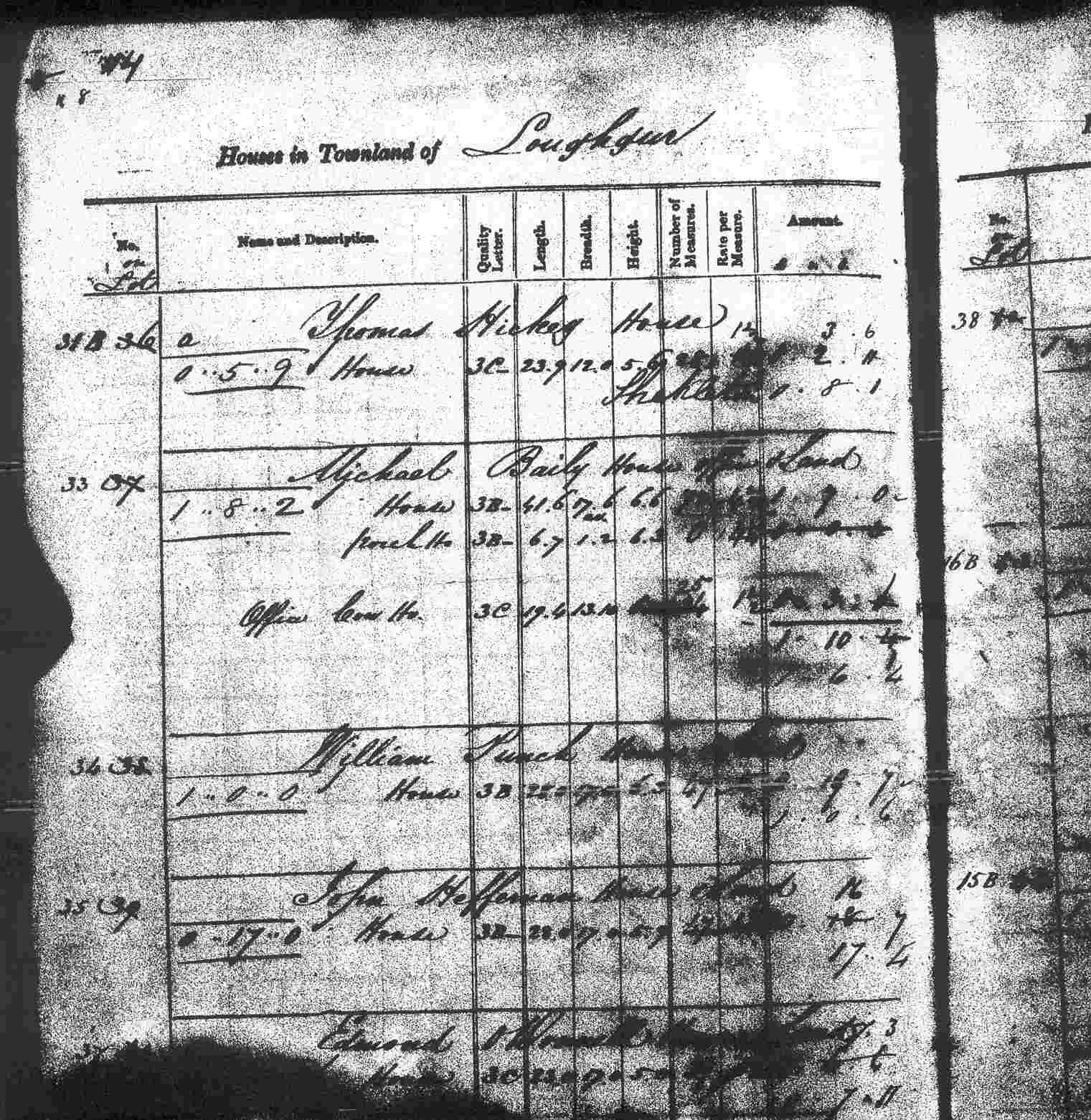
House Book, Loughgur, Knockaney parish
In Griffiths Valuation of 1851, the Hickeys were found on
two pieces of property, in lot 11a and lot 35a. In lot 11a,
Thomas was renting a house, office and just over six acres
of land from the Count de Salis. Bridget McGrath was show in
Lot 10a. In lot 35a, Thomas was renting a small house only
(worth eight shillings) with no land, from Patrick Gourey.
This is the old, dilapidated property shown in the House
Books.
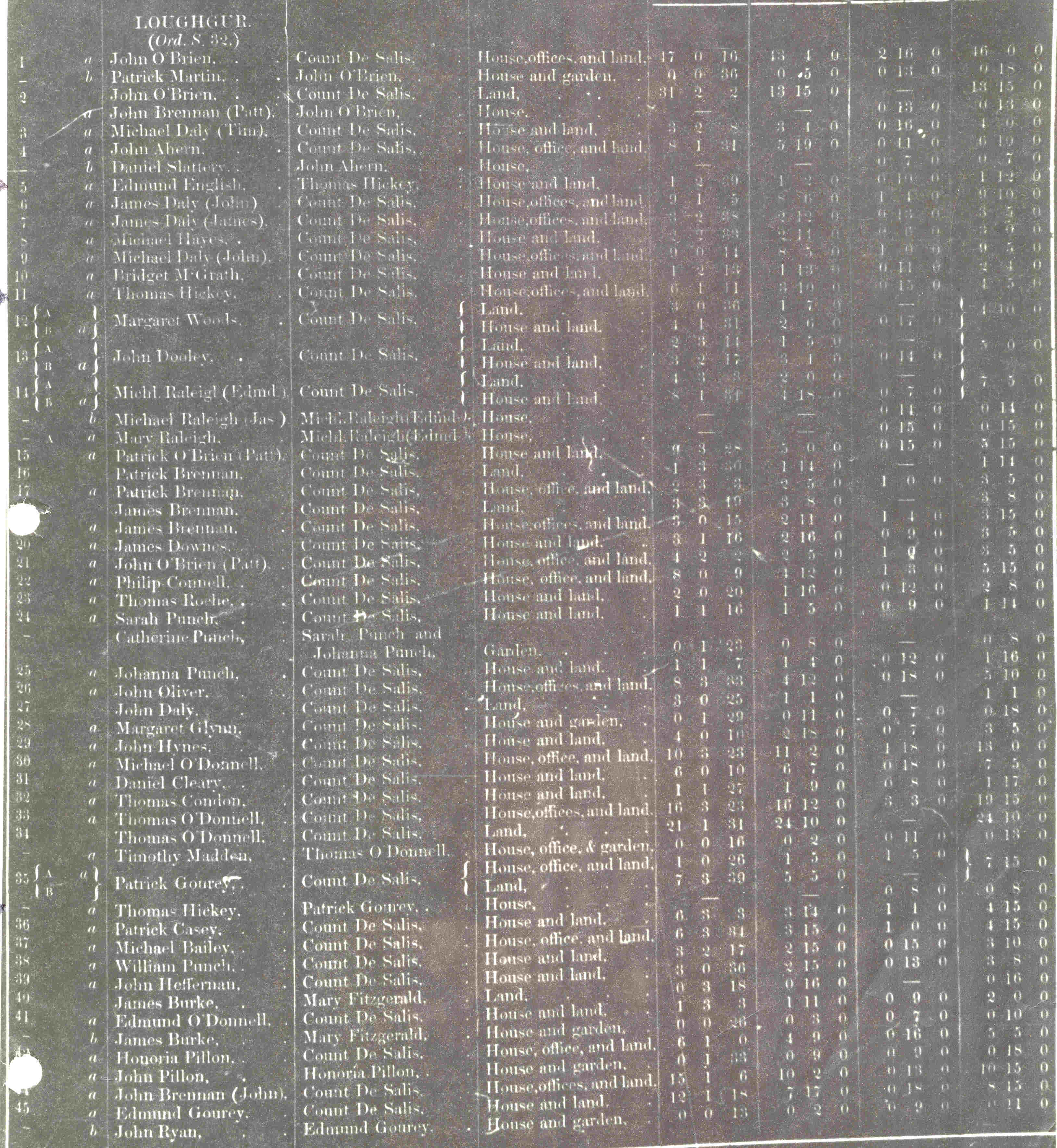
Their neighbors were the Dalys, the O'Donnells, and McGraths. The Dalys and the McGraths were sponsors at the baptisms of the Hickey children. Another neighbor was Edmund English, who leased a small lot from Thomas Hickey.
The land valuations continued, and
in 1862, Ellen Hickey was shown renting the house, offices
and land. Thomas must have died between 1851 and 1862, and
left Ellen as head of household. The smaller house was still
shown as being rented by Thomas Hickey. This cannot be
Thomas's son, Thomas, as he emigrated to America in 1857,
had children in Chicago, and died in Chicago in 1865.
Patrick Hickey's son, Thomas, who later inherited the farm
was still too young to be the Thomas Hickey listed, as he
was only about seven years old. Possibly this was Maurice's
son Thomas.
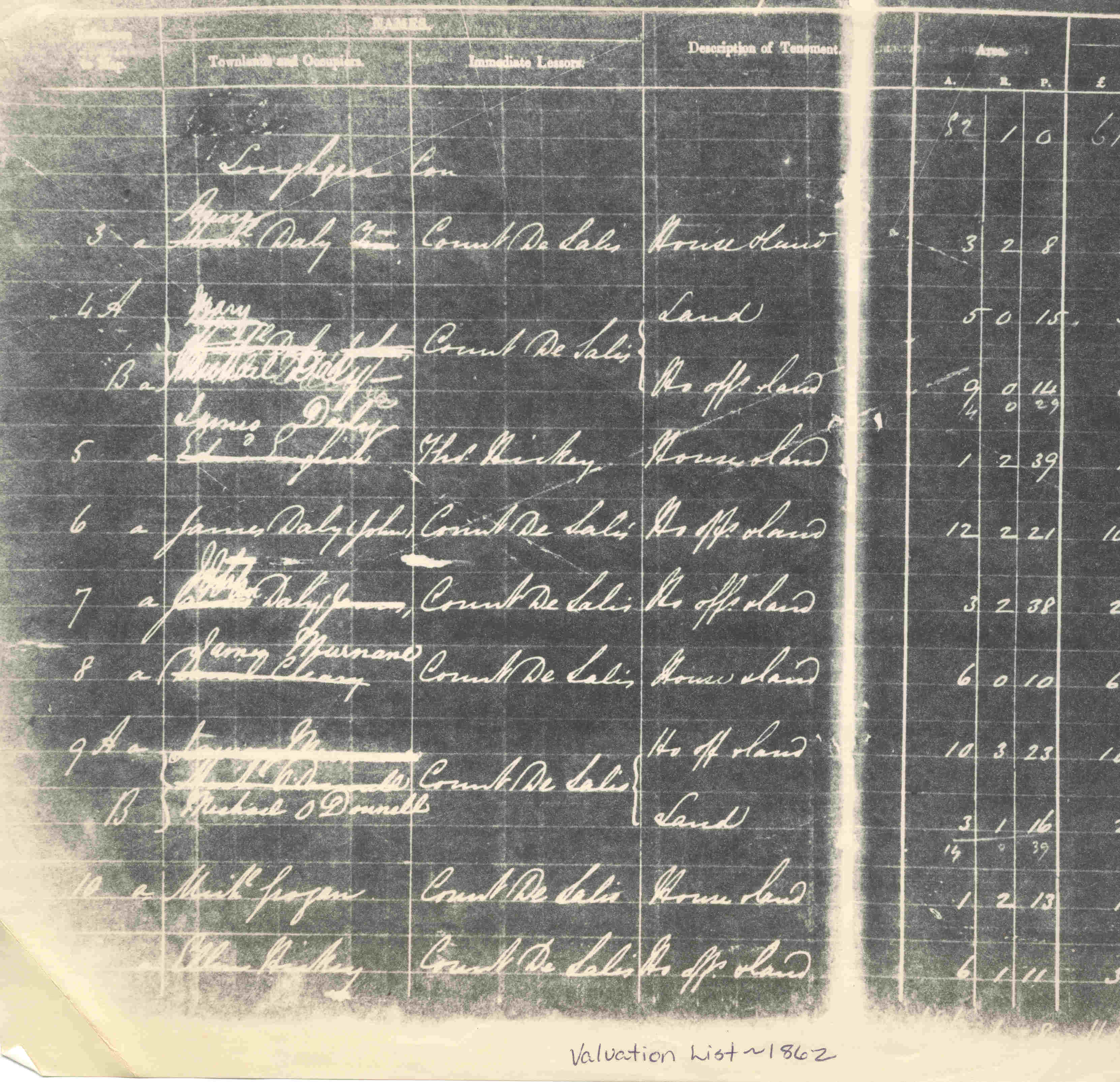
Valuation List, Loughgur, Knockaney parish, 1864
Thomas and Ellen's son Maurice
(age 20) and daughter Ellen (age 12) emigrated to America
together in September 1857, and settled in Chicago. Their
son Thomas had also emigrated to Chicago that year. Daughter
Catherine was married and living in Ballybrickeen. Bridget
emigrated to Chicago by 1861. Son John also emigrated to
Chicago, but the date is unknown.Son Patrick was married and
had four young children.
Two interesting cases were filed in Petty Court in 1858. The
complainant was Ellen Hickey of Knockroe, and the defendant
was Patrick Hickey of Knockroe.

Petty Session Court Registers, 13 April 1858

Petty Session Court Registers, 13 April 1858
Ellen was still shown on the same property in 1864, 1865,
1870 and 1873. The smaller house was still rented by Thomas
Hickey. In 1870, Thomas Hickey was lined out on the
valuation, and the house was shown as down.
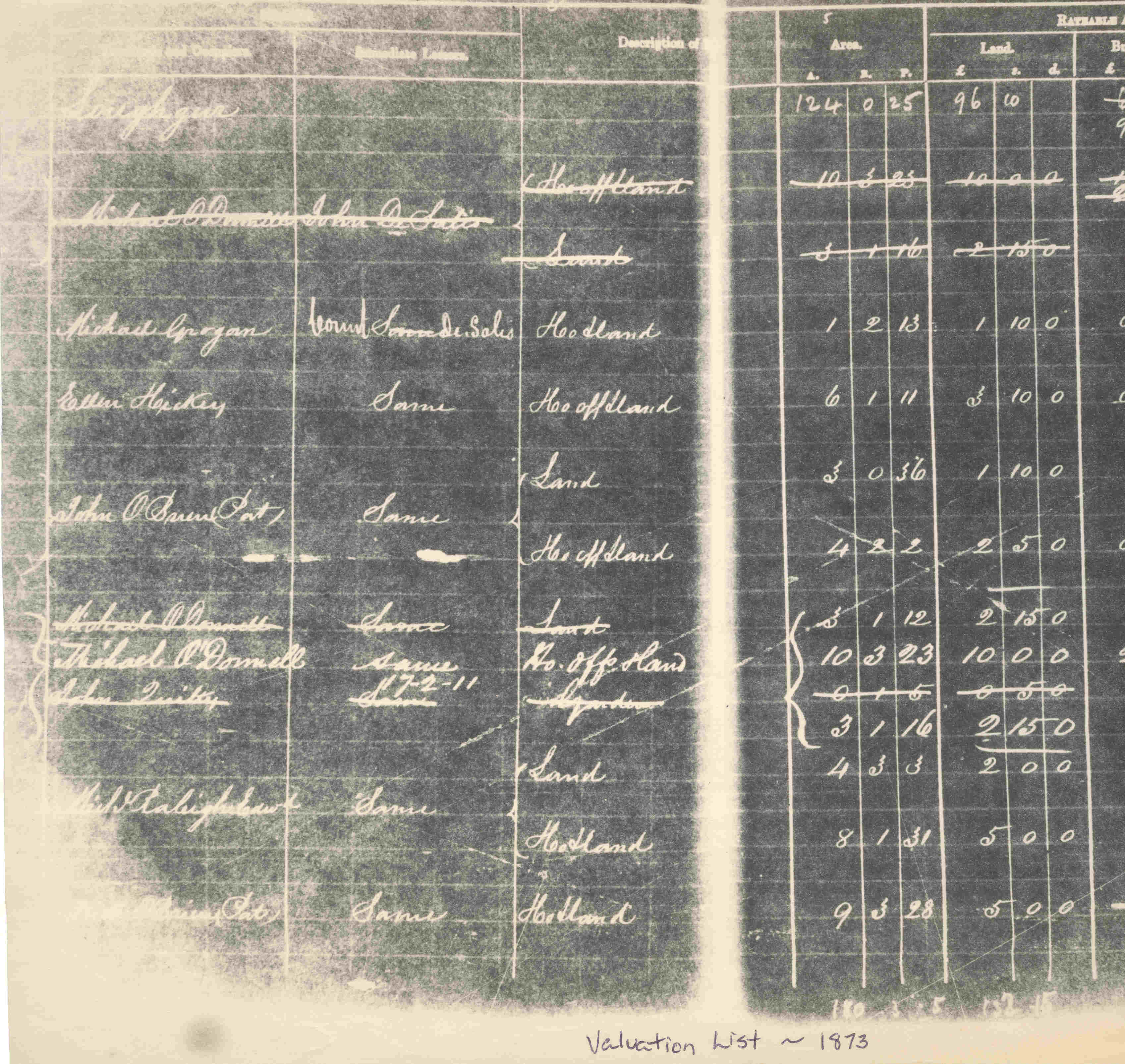
Valuation List, Loughgur, Knockaney parish,
1865-1873
In 1889 Ellen Hickey was crossed out, and the land passed
to Thomas Hickey. This Thomas (born 1855) was the oldest son
of Patrick Hickey, Thomas and Ellen's oldest son. Patrick
had died of bronchitis in 1867. Ellen probably died in about
1889. Her son Maurice's daughter remembered that her father
returned to Ireland once. It may have been to see his mother
or for her funeral.
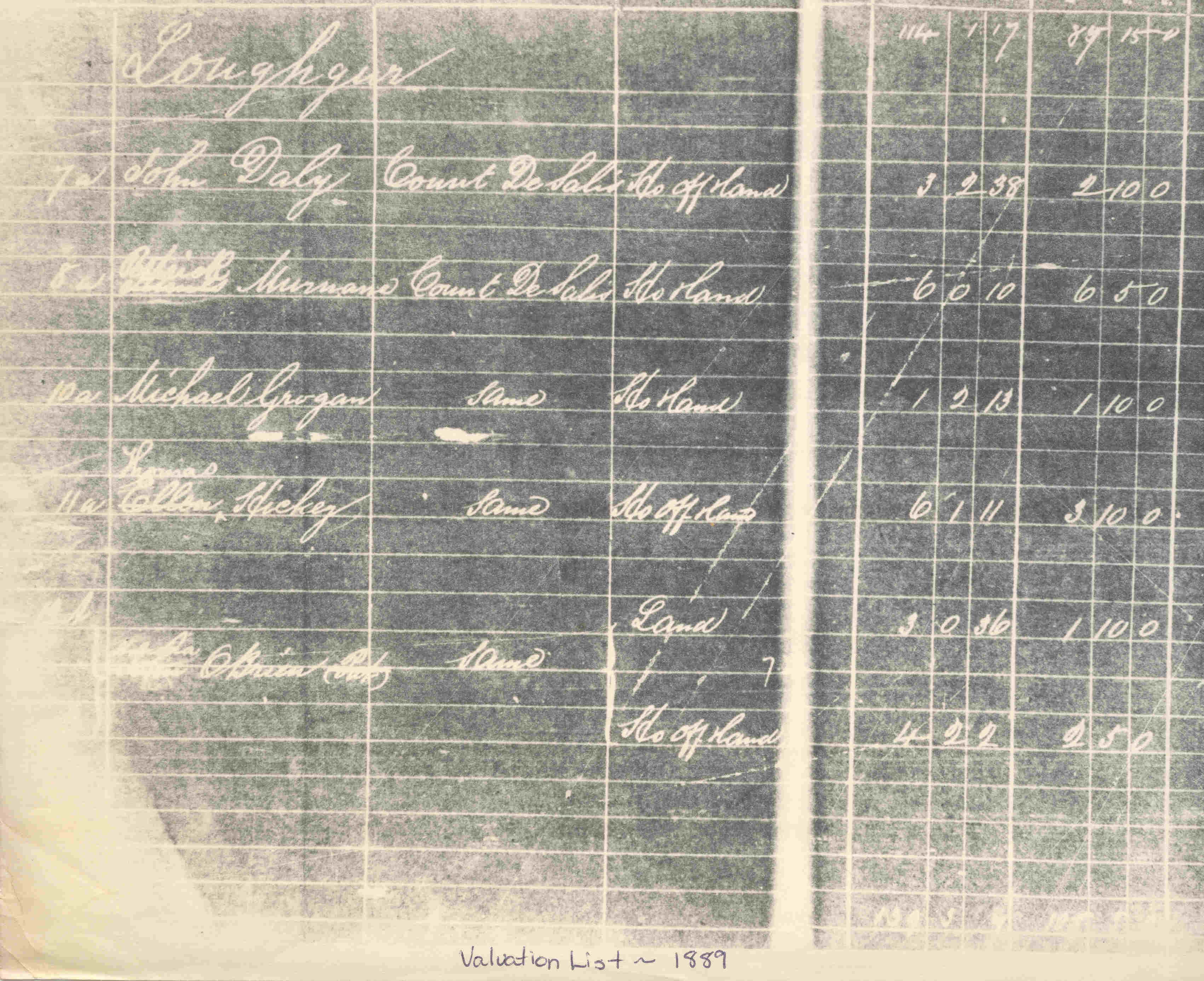
Valuation List, Loughgur, Knockaney parish, about 1889
Lot 11a passed from Thomas Hickey to Ellen Hickey, his
widow, to Thomas Hickey, their grandson. It then passed to
Thomas' widow, Mary, and then to Michael Hickey. The land
still belongs to the Hickey family. It is currently owned by
Thomas Hickey, a great-great grandson of our Thomas Hickey.
He and his family live in the house, which he says is about
200 years old. The walls are of thick stone, and a beam with
hooks for hanging hams is high above the fireplace. On the
hill near the house, under a berry bush, is the foundation
of the old house, which Mr. Hickey says is probably 400
years old or more. The Hickey family is considered to be one
of the oldest names in the town, and has been there as long
as anyone can remember.
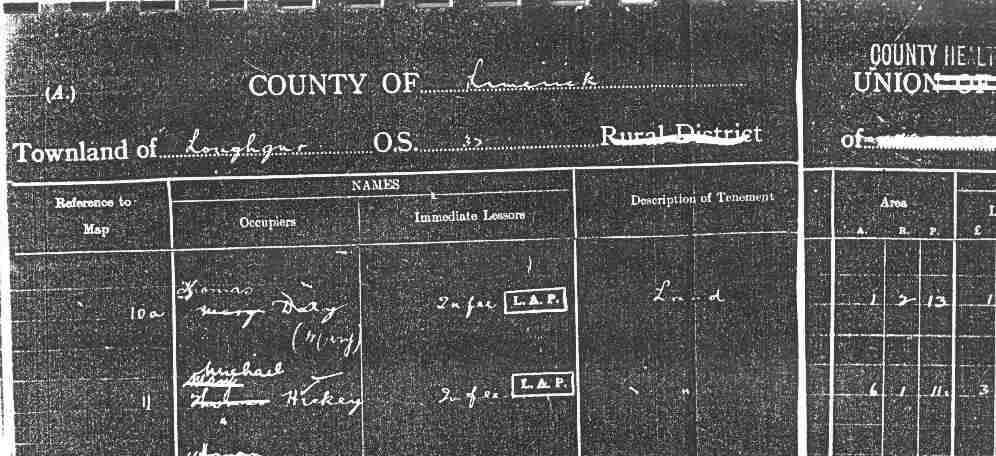
Land Valuation list of 1933-1940, showing Lot 11 passing from Thomas Hickey to Mary Hickey and then Michael Hickey
Lough Gur is a flat, silvery lake of about four miles in
circumference. It has two beautiful islands. The ruins of a
castle, Bourchier's Castle can be found in a farmyard next
to the lake. A description of Lough Gur is given in the book
"The Farm by Lough Gur" by Mary Carberry. This
autobiographical book describes the life of a young girl,
born in 1858, who grew up by Lough Gur. Her father was John
O'Brien, a close neighbor of the Hickeys. Tom Hickey, Thomas
and Ellen's son was the head man on the O'Brien's farm. She
describes Lough Gur in this way: "When I think of home I see
first Lough Gur, lying in summer sunshine like a bright
mirror, in which are reflected blue sky, bare hills,
precipitous grey rocks and green pastures dotted with cattle
and sheep; then a small white house, half-hiding the farm
buildings behind it. Lough Gur with its ruined castles;
Knockadoon and Knockfennel with their caves ancient forts;
the stone-circles, the cromlechs and gowlauns were
enchanting places to play in. The green hills were covered
with sheets of ragweed and willow herb, loosestrife and
furze, tiny pansies in the short turf, and bog cotton. Lough
Gur dominates the scene. It was to us a personality loved,
but also feared. Every seven years, so it is said, Gur
demands the heart of a human being. Drownings were not
infrequent and, as the bodies of the drowned were sometimes
not recovered, Gur was said by some to be a bottomless
lough. In the lake is Knockadoon hill, joined to the land by
a causeway built on the isthmus, once guarded by two
fortresses where now only one, the ruined Black Castle,
remains. Sometimes we children climbed by a steep and stony
way to the summit of Knockadoon, where, when father was a
boy, eagles made their nest and flew about the hills
searching for leverets and newborn lambs to feed their
young. From the top of Knockadoon we could see Garret
Island, interesting for its prehistoric remains which were
visited from time to time by antiquaries who gave my mother
curious implements of the stone age in return for her
hospitality."
Lough Gur is the site of a major
archeological find. A Neolithic (about 3000 B.C.) settlement
site was found in the light limestone soils around Lough
Gur. In Lough Gur, farmers from Neolithic into Bronze Age
times, and herdsmen, lived on the same sites in dwellings of
stone and sticks. Other Lough Gur finds include Bronze Age
pottery, and Irish ritual circles, and pillarstones. In
Lough Gur townland is a National Monument, a wedge-shaped
gallery grave, in which were buried more than twelve
individuals. Mary Carberry recounts local beliefs about
ancient peoples: "Lough Gur has been called the Enchanted
Lake; some say that in ancient days there was a city where
the lake is now, before an earthquake threw up the hills and
filled the hollow with water so that the city was submerged.
The hills round Gur are bare of trees, but once they were
covered with forest. Great giants, who were among Ireland's
first people, hunted in the woods. On Baile-na-Cailleach one
of these giants lies buried in a stone coffin with a long
gold sword beside him. Old people who lived on the shore
believed that the giants built the stone circles which stand
near the lake, for who but giants could move such great
stones?"
Lough Gur townland is in the parish
of Knockainy. Knockainy (or Aney) is a parish in
Smallcountry Barony, in County Limerick. In 1837, Knockainy
had a population of 4542 inhabitants. Knockainy takes its
name from Cnoc Aine, which means the hill of Aine. In Irish
mythology, Cnoc Aine is the Otherworld seat of the
sun-goddess, Aine. Until 1879, men used to bring flaming
cliara (bunches of hay and straw on poles) to the summit of
Cnoc Aine. Then they would visit villages, fields, and herds
to bring good luck. The cemetery sits atop the hill
overlooking the ruined castle of the Ormonds.
Lough Gur had its own legend.
Gerald the Rhymer, Earl of Desmond, who disappeared in 1398,
is said to sleep beneath its waters. Every seventh year he
emerges to ride the moonlit ripples of the lake, on a horse
with silver shoes.
There were also many local beliefs
and superstitions associated with holidays. May-Eve was
supposedly a night when evil powers were most powerful. Mary
Carberry recounts the stories she heard on a May-Eve from
Tom Hickey (Thomas and Ellen's grandson):
"Tis not the Good People I'd be in dread of in the dark of
night," Tom told them, "but to hear the cry of the Ould
Kings. There's them that thinks they'll be on the move once
more. The last time was in '48. My father was on the top of
Knockfennel, tending the Bel-fire with a score of the
neighbors when the cry of the Ould Kings struck upon them.
It came rolling like thunder over the mountains from south
to north, from east to west it rolled, from sea to sea! And
the ground heaved and broke, and rising from the clay came
the army of the dead. Ould warriors were there with their
ould war-horses; foot soldiers and trumpeteers and drummers
and all, waiting for the word of command! Up the Shannon it
came, along the rally and over Lough Gur, loud as
judgement-day, so everyone, living and dead, must hear the
cry of the Ould Kings. Then the army gave an answering
shout, clashing their shields and rattling their swords, and
letting out the ould war-cries of the people." "Whatever
for?", asked Bridgie, who was rather matter-of-fact.
"There's but the one thing," Tom answered, "and that's
Ireland! 'Twas to encourage the living to fight for her like
them ould warriors fought."
On Halloween night chairs were set
out for deceased family members to return to their old homes
in comfort. Mary Carberry remembers, "Father read the litany
for the Dead. We made the responses in hushed voices as if
we were listening for the rustling of home-faring souls.
Father prayed for his own dead and for mother's by name. He
prayed for Tom Hickey's father:
Eternal
rest grant to them, O Lord
And may perpetual light shine upon them."
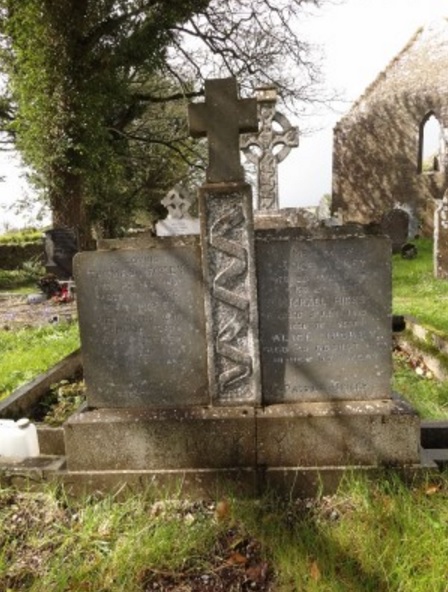
The Hickey family
gravestone in New Church, Lough Gur
The first person on the stone is Thomas Hickey, born
about 1853, died 1931.
This is most likely where the other Hickey family
members are buried.
(http://historicgraves.com/new-church-lough-gur/li-lgtn-0035/grave)
The O'Hickeys were formerly Chiefs of a district in the
vicinity of Killaloe, County Clare, also a cantred in the
barony of Upper Connello, County Limerick. They were
hereditary physicians to the O'Briens, Kings of Thomond, to
the MacNamaras, lords of Hy-Caisin, and to the O'Kennedys of
Ormond. Several of them are said to have compiled and
translated valuable medical works, including a Latin Medical
work, "The Rose". The O'Hickeys possessed a copy of "The
Rose", a celebrated medical work compiled in 1344. The
Hickeys are one of the Milesian families of Ireland, and it
is said that a banshee attends the death of a member of the
family.

This ordnance survey map shows the area of Knockroe in
Lough Gur, where the Hickeys lived. The names of their
neighbors have been added from Griffiths Valuation.
Griffiths Valuation was a land census taken in 1851. This
shows what the neighborhood was like when Maurice Hickey
was a boy, at about 12 years old. Many of his neighbors
acted as witnesses for family christenings. The Hickey
family is found in Lots 11A and 35B, and also leasing to
neighbor Edmund English in Lot 5A. Bridget McGrath,
Thomas' sister occupied lot 10a. John O'Brien, whose
daughter wrote "The Farm by Lough Gur" is found in
Lot 1.
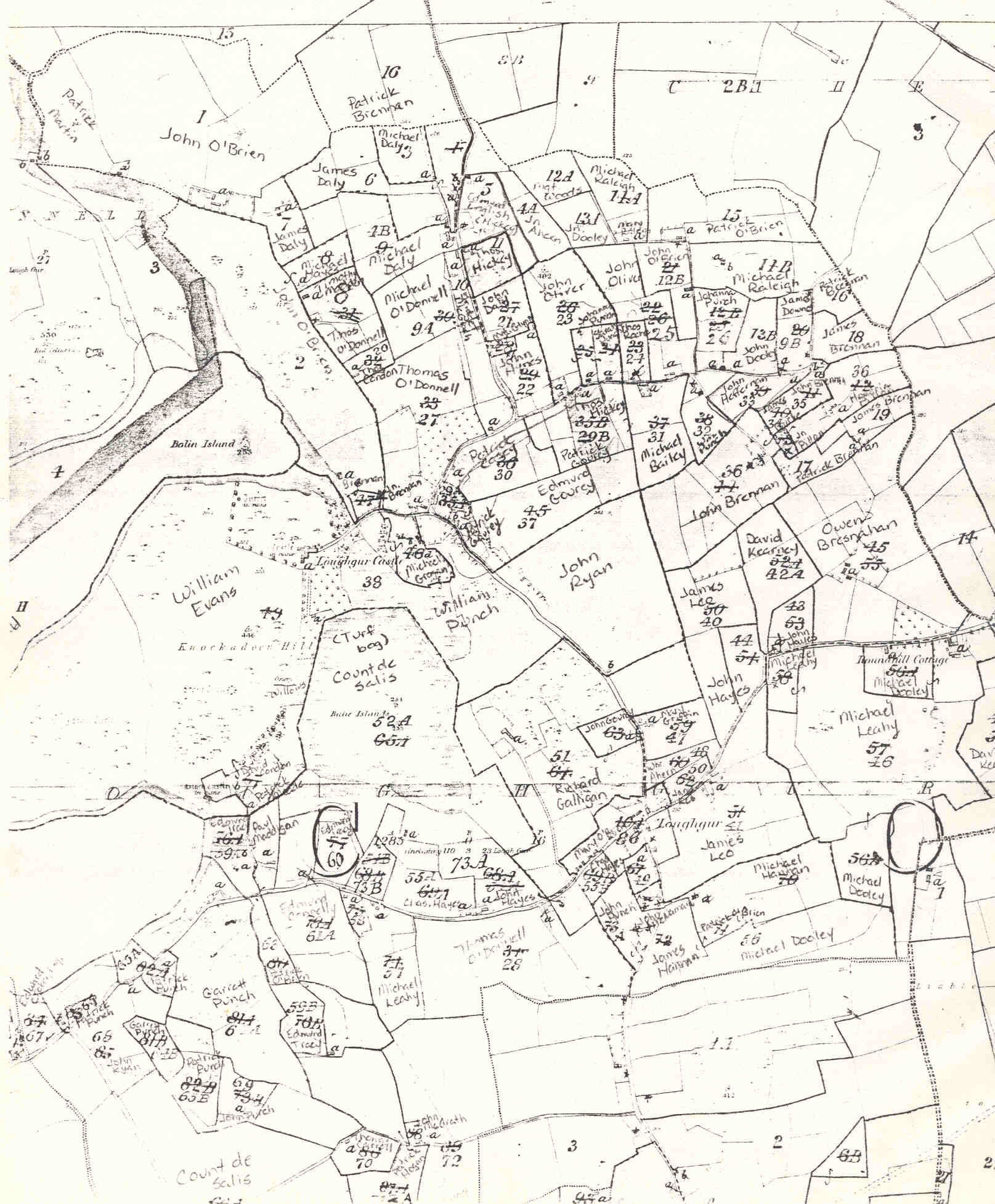
The occupants of Lough Gur townland in 1851 as found in
Griffiths Valuation were:
John O'Brien
Patrick Martin
John Brennan (son of Patrick)
Michael Daly (son of Tim)
John Ahern
David Slattery
Edmond English
James Daly (son of John)
James Daly (son of James)
Michael Hayes
Michael Daly (son of John)
Bridget McGrath
Thomas Hickey
John Dooley
Margaret Woods
Michael Raleigh (son of Edmund)
Michael Raleigh (son of James)
Mary Raleigh
Patrick O'Brien (son of Patrick)
Patrick Brennan
James Brennan
James Downes
John O'Brien (son of Patrick)
Phillip Connell
Thomas Roche
Sarah Punch
Catherine Punch
Johanna Punch
John Oliver
John Daly
Margaret Glynn
John Hynes
Michael O'Donnell
Daniel Cleary
Thomas Condon
Thomas O'Donnell
Timothy Madden
Patrick Gourey
Thomas Hickey
Patrick Casey
Michael Bailey
William Punch
John Heffernan
James Burke
Edmond O'Donnell
Hanoria Pillon
John Pillon
John Brennan (son of John)
Edmond Gourey
John Ryan
Michael Grogan
David Condon
Daniel McNamara
Denis and Mary Halvey
John Brennan (son of Patrick)
William Evans
John Dooley
James Leo (son of Patrick)
David Kearney
Michael O'Brien
John Hayes
Owen Bresnahan
Michael Dooly
Michael Leahy
Mary Griffin
William Ahern
James Leo (son of James)
John Gourey
Richard Galligan
Michael Grady
Phillip Dooly
Patrick Meade
David Condon
John Hayes (son of Charles)
Charles Hayes
Michael Hannan
Patrick O'Brien (Hannan)
James Hannan
John Punch
John McNamara
John Condon
Edmund Tracy
Paul Maddigan
Edmund Connolly
James Fitzgerald
Patrick O'Brien (son of John)
Garrett Punch
Patrick Punch
Edward J. Croker, Esq.
John Ryan
Sarah Kelly
Catherine Punch
Thomas Carroll
Patrick Hogan
John McGrath
Johanna Kelly
Mary Casey
Patrick Hennessy
Thomas Hayes (Batt.)
Hames Fitzgerald
Timothy Mulcahy
Michael Ryan
Edmond Ryan
Patrick Kennedy
Thomas Hayes (Michael)
Patrick Carroll
Michael Dwyer
Patrick Dooly
Thomas Dooly
Michael McCann
Timothy Dooly
Margaret Dooly
Edmund Connolly (son of Edmund)
For a
video of the Lough Gur area, click
here.
FAMILY GROUP RECORD OF
THOMAS
AND MARY HICKEY
This family group is speculative. Based on the family
naming patterns it is possible that the parents were
Thomas and Mary Hickey. Their children would be:
1. Bridget, born in about 1795; married John
McGrath 27 May 1816 in Knockainy, listed as being of
Knockroe township; had children Mary (1817), Bridget
(1820), Thomas (1822), and Ellen (1825); died between 1851
and 1862.
2. Thomas, born in
about 1800; married Ellen Allen 8 August 1823 in Bruff; of
Lough Gur; died between 1851 and 1858.
3. Maurice, born in
about 1802; married Ellen Sherwin 27 November 1823 in
Dromin and Athlacca; had children Mary (1824), Thomas
(1827), and William (1830).
4. John, born in
about 1804; married Anne Donovan; had children: Mary
(1821) and Bridget (1925); died of head injuries from a
fight in Lough Gur 7 March 1836, brother Maurice testified
at trial in 1838.
SOURCES: Tithe
Applotment; Griffiths Valuation; Valuation Lists; 1901
census; The Lough Gur & Districk Historical Society
Journal, 1988; Knockainy parish register; Limerick
Ancestry at www.limerick.brsgenealogy.com; Limerick
Journal at
http://www.limerickcity.ie/Library/LocalStudies/ObituariesdeathnoticesetcfromtheLimerickChronicle/1838/;
Family Commission Relief Papers, 1844-7,
www.ancestry.com; Petty Session Court Registers,
www.findmypast.com.